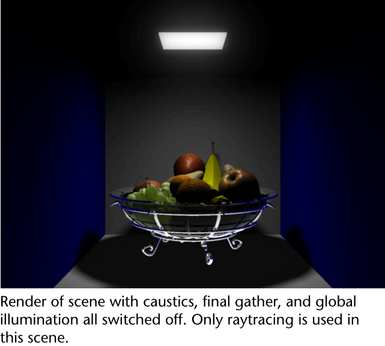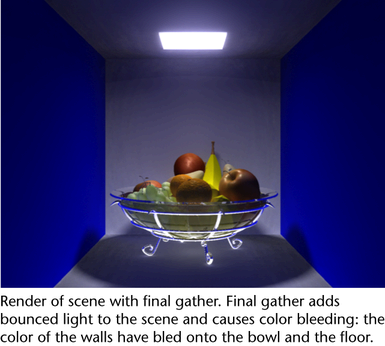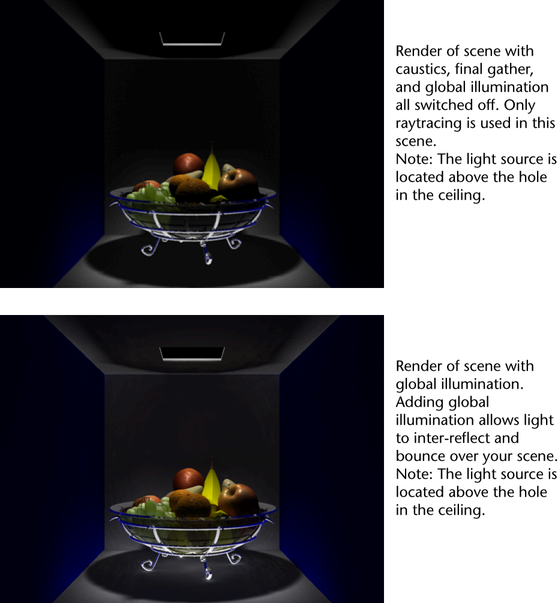All of global illumination, caustics and final gather contribute to indirect illumination. When global illumination or caustics is incorporated in your scene, mental ray for Maya uses photons to simulate light inter-reflection and caustics effects. When final gather is incorporated in your scene, however, mental ray for Maya does not use photons but instead samples the semi-hemispherical area above every point in the scene to calculate the direct and indirect illumination. Since photons are not used for final gather, final gather requires the least rendering time out of the three options.
Global illumination is commonly used to describe all forms of indirect light. It is often assumed to encompass all of global illumination, caustics and final gather. However, the definition of global illumination is different in mental ray for Maya. In mental ray for Maya, global illumination, caustics and final gather are three separate techniques. Global illumination simulates diffuse light bouncing multiple times over an area until it is completely absorbed.
Use global illumination when you need light to inter-reflect and bounce multiple times over a large area in your scene. A sample application would be a long hallway with light entering from the doorway. The use of global illumination (out of the three options listed above) allows the greatest number of light reflections and allows light to bounce off the furthest. Global illumination also prevents the darkening of corners and adds softness to the final render. Use global illumination to avoid the hard-edged CG look that lacks the softness of natural light.
Using global illumination with caustics
Global illumination is not used for the focusing of light (that is, reflection and refraction). It is generally used with diffuse materials or for simple transparency. If you need to add refractions, then incorporate caustics in your scene.
Using global illumination with final gather
Use final gather to add fine details to your scene. When global illumination is used, photons usually miss cracks and crevices in objects and therefore these areas may appear artificially dark. Final gather adds details by adding light to the scene; brightening and softening it and making the final render more realistic.
If details are washed out by global illumination because your scene is too bright, use ambient occlusion to add detail to your scene by subtracting light.
Use caustics for specular reflection and refraction. If your scene consists of shiny surfaces that refract, reflect, and focus light, then you should use caustics. Caustics are generally not used for simple transparency. Some sample applications of caustics are simulating the reflection of light off a disco ball or the distortion of light at the bottom of a swimming pool.
Using caustics with global illumination
Generally, you use caustics with global illumination rather than in combination with final gather. Often final gather is chosen because it saves rendering time. However, since caustics require the use of photons, the addition of final gather does not reduce memory requirements or rendering time. Therefore, it is more efficient to use global illumination in combination with caustics instead.
Final gather adds details to your scene by adding light. It is similar to global illumination, but is more limited because it does not handle multiple bounces of light as accurately or efficiently. It does, however, require the least rendering time out of the three techniques. Final gather is traditionally used with diffuse materials, for example paper, chalk, and so on. It also handles small details better than the other illumination options.
Using global illumination, caustics and final gather
Incorporate all the types of illumination (global illumination, caustics and final gather) in your scene if you want to have a lot of bounced lights (from global illumination), you have objects with materials that reflect or refract (caustics), and you want to include soft lighting to show small details (final gather).
Final gather, caustics and global illumination sample scene
In the scene below (see image), the fruit and glass fruit bowl are contained in a Cornell box, which is commonly used to create test scenes for global illumination, caustics, and other light effects. The only light source is a spotlight in the ceiling of the box.



